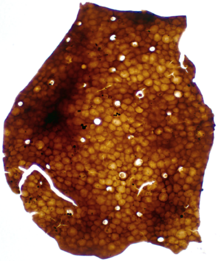- Nematophyta
-
Nematophyta
Temporal range: Cambrian–410[1] Upper Silurian – lowermost Devonian
Cuticle of Cosmochlaina, retrieved from the Burgsvik beds by acid maceration. Cells about 12 μm in diameter. Scientific classification 
Kingdom: Plantae (?) Phylum: Nematophyta
Strother 1993[2]Class: †Nematophytina
Strother 1993Order: †Nematophytales
Lang 1937[3]Genera Family Nematothalaceae:
- Nematothallus Lang, 1937
- Cosmochlaina Edwards, 1986
Family Nematophytaceae:
- Nematoplexus Lyon, 1962
- Nematasketum Burgess and Edwards, 1988
- Prototaxites Dawson, 1859[4]
The Nematophytes are a group of land organisms, probably plants (although their biochemistry is consistent with an algal affinity),[5] known only from the fossil record, from the Silurian period until the early Devonian Rhynie chert.[6] Its type genus Nematothallus, which typifies the group, was first described by Lang in 1933,[3] who envisioned it being a thallose plant with tubular features and sporophytes, covered by a cuticle which preserved impressions of the underlying cells. He had found abundant disaggregated remains of all three features, none of which were connected to another, leaving his reconstruction of the phytodebris as parts of a single organism highly conjectural.
The lack of a clear definition of the nematophytes has led to it being used as a wastebasket form taxon, with all manner of tubes and cell-patterned cuticles from around the Silurian being dubbed "Nematophytic" more as a statement of ignorance than as a scientifically meaningful statement.
Linnean taxonomy struggles to accommodate most fossil groups, as they tend to form stem groups to modern taxa. Thus despite Strother's attempts to formalise the nomenclature of Nematothallus, the hierarchy of class, order and family are better thought of as a stem group to the embryophytes (modern land plants), with the green algæ a stem group to the Nematophytes in turn. Indeed, since no reproductive or vegetative structures common to the land plants are seen, it may not be safe even to assume this relationship.[7]
References
- ^ Graham, L.; Wilcox, L.; Cook, M.; Gensel, P. (2004). "Resistant tissues of modern marchantioid liverworts resemble enigmatic Early Paleozoic microfossils". Proceedings of the National Academy of Sciences of the United States of America 101 (30): 11025–11029. Bibcode 2004PNAS..10111025G. doi:10.1073/pnas.0400484101. PMC 503736. PMID 15263095. http://www.pubmedcentral.nih.gov/articlerender.fcgi?tool=pmcentrez&artid=503736.
- ^ Strother, P.K. (1993). "Clarification of the Genus Nematothallus Lang". Journal of Paleontology 67 (6): 1090–1094. doi:10.2307/1306131. JSTOR 1306131.
- ^ a b Lang, W.H. (1937). "On the Plant-Remains from the Downtonian of England and Wales". Philosophical Transactions of the Royal Society of London. Series B, Biological Sciences 227 (544): 245–291. Bibcode 1937RSPTB.227..245L. doi:10.1098/rstb.1937.0004. JSTOR 92244.
- ^ Included in the Nematophyta by Taylor, W. A.; Wellman, C. H. (2009). "Ultrastructure of Enigmatic Phytoclasts (Banded Tubes) from the Silurian-Lower Devonian: Evidence for Affinities and Role in Early Terrestrial Ecosystems". PALAIOS 24 (3): 167–180. doi:10.2110/palo.2008.p08-046r.
- ^ Niklas, K. J. (1976). "Chemical Examinations of Some Non-Vascular Paleozoic Plants". Brittonia 28 (1): 113–137. doi:10.2307/2805564. JSTOR 2805564. http://www.springerlink.com/index/P481077W46U31855.pdf.
- ^ Fayers; Trewin, Nigel H. (2003). "A review of the palaeoenvironments and biota of the Windyfield chert". Transactions of the Royal Society of Edinburgh Earth Sciences 94. doi:10.1017/S0263593300000729.
- ^ Strother, P.K. (1988). "New Species of Nematothallus from the Silurian Bloomsburg Formation of Pennsylvania". Journal of Paleontology 62 (6): 967–982. doi:10.2307/1305385. JSTOR 1305385.
McGregor and Narbonne (1978): "Upper Silurian trilete spores and other microfossils from the Read Bay Formation, Cornwallis Island, Canadian Arctic"
Categories:- Prehistoric plants
- Silurian life
- Devonian life
Wikimedia Foundation. 2010.
